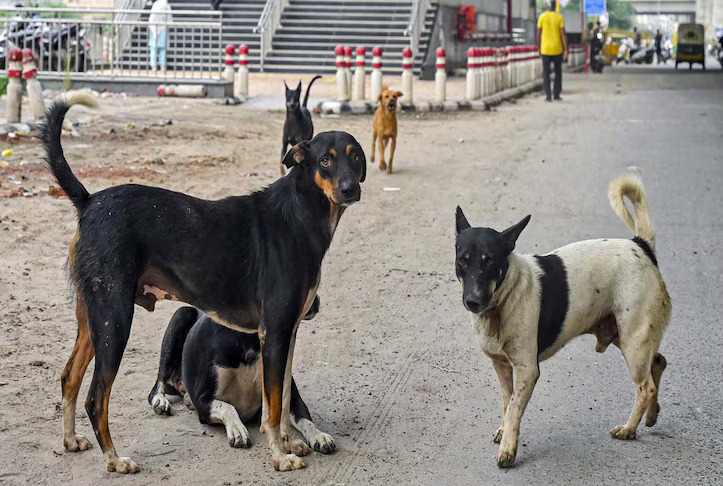Delhi, India sprawling capital, is no stranger to civic challenges. From toxic air to chronic traffic jams, residents have learned to navigate the city’s daily struggles. But in 2025, one problem has managed to unite fear, outrage, and compassion in equal measure — the stray dog crisis. This is not simply a question of animal control; it is a test of governance, public health management, and moral responsibility.
Recent Supreme Court orders to remove all stray dogs from Delhi-NCR streets have ignited intense debate. For some, the move offers hope for safer streets. For others, it signals a dangerous turn toward inhumanity. With over 500,000 dogs estimated to be living on the streets, the stakes have never been higher — for humans and animals alike.

The Supreme Court Order That Shook the City
In August 2025, the Supreme Court issued a landmark directive following an alarming rise in dog bite cases. The statistics are sobering: more than 2,000 reported bites daily in Delhi alone, with many more likely unreported. Several cases involved children and senior citizens, sparking public outcry and urgent petitions to the courts.
The court’s orders included:
- Immediate capture and relocation of all stray dogs in Delhi, Noida, Gurugram, and Ghaziabad to authorized shelters.
- No release back into original locations, even for sterilized dogs — a move that contradicts the long-standing Animal Birth Control (ABC) Rules.
- Creation of dedicated municipal helplines for dog-related complaints, with a mandatory response time of under four hours.
- Legal penalties, including contempt of court charges, for any individual or organization obstructing the removal process.
The court stressed that while compassion for animals is important, “the right to life and safety of citizens must take precedence.”
A City Divided: Safety vs. Sentiment
Public Safety Concerns
For many residents, especially families with young children and elderly parents, the Supreme Court’s order is seen as overdue. Dog bites have become a routine fear. Some neighborhoods report multiple incidents in a single week, with delivery workers, joggers, and schoolchildren among the victims.
“I used to take evening walks with my mother. Now, we avoid going out after sunset. Packs of strays roam the streets, and it’s just not safe,” says Rajesh Sethi, a resident of West Delhi.
Voices for the Voiceless
Animal welfare groups see the situation differently. Organizations like PETA India, People for Animals, and countless grassroots feeders argue that the court’s order ignores decades of scientific and humane management practices under the ABC Rules. These rules mandate sterilization, vaccination, and return of dogs to their original territories to prevent territorial vacuums and population surges.
Prominent animal rights advocate Maneka Gandhi has been especially vocal, calling the order “cruel, impractical, and legally unsound.” Critics warn that overcrowded shelters will become disease-ridden holding pens, potentially leading to euthanasia by neglect.
The Public Reaction Spectrum
The stray dog crisis has created a sharp divide among citizens, with opinions ranging from strong support for removal to passionate defense of street animals.
- Resident Welfare Associations (RWAs): Most RWAs back the court’s decision, citing safety concerns and rising insurance claims related to bite injuries.
- Animal Activists: Advocate for mass sterilization instead of relocation, warning of cruelty and public backlash.
- Veterinarians: Stress the need for vaccination drives alongside sterilization to prevent rabies outbreaks.
- General Public: Many remain conflicted, wanting safer streets but uncomfortable with the idea of large-scale animal displacement.
How Did Delhi Get Here?
The roots of Delhi’s stray dog crisis stretch back decades, shaped by policy failures, urban change, and environmental factors:
- Chronic Underfunding of ABC Programs: Many municipal zones operate with sterilization rates below 30%, far short of the 70% threshold needed to control populations.
- Rapid Urbanization: Construction projects and gentrification displace established dog packs, forcing them into unfamiliar areas where human-dog conflict increases.
- Garbage Mismanagement: Open waste sites and overflowing dumpsters provide constant food sources, enabling rapid breeding.
- Territorial Instability: Removing one pack often invites new, unsterilized dogs to occupy the territory, restarting the cycle.
Case Study: Noida Sector 62
In Noida’s Sector 62, residents recently reported a surge in aggressive dog behavior after a rival pack moved in when the original group was relocated. Within a month, three bite incidents occurred — all involving schoolchildren. This illustrates how displacement without sterilization can worsen problems rather than solve them.
The Legal Crossroads
The conflict between the Supreme Court’s directive and existing ABC Rules has sparked a broader debate about judicial authority. The ABC Rules, introduced in 2001 under the Prevention of Cruelty to Animals Act, are designed to manage stray populations humanely. They explicitly prohibit relocation except in cases where the animal is aggressive, rabid, or unwell.
Legal experts warn that bypassing these statutory rules without parliamentary amendment could set a dangerous precedent. The court’s defenders, however, argue that extraordinary circumstances — such as the current bite epidemic — justify extraordinary measures.
As of mid-August 2025, the matter has been referred to a three-judge bench for further review, but implementation in many areas is already underway.
Health Risks & Data
Dog bites are not just a nuisance — they can be deadly. According to the World Health Organization (WHO), India accounts for nearly 36% of global rabies deaths, with an estimated 18,000–20,000 fatalities annually. Rabies is almost always fatal once symptoms appear, but 100% preventable through timely vaccination.
WHO guidelines recommend that countries with large stray dog populations focus on mass dog vaccination as the primary method to eliminate rabies, combined with community awareness and responsible pet ownership laws.
Without a robust sterilization and vaccination program, Delhi risks trading one public health crisis (bites) for another (rabies outbreaks in overcrowded shelters).
Can Delhi Really Shelter Half a Million Dogs?
On paper, the Municipal Corporation of Delhi plans to build 12 new shelters, each capable of housing hundreds of dogs. In reality, Delhi’s estimated stray population ranges from 500,000 to 1,000,000. Even if all planned shelters were built tomorrow, they would accommodate less than 5% of the total population.
Challenges include:
- Shortage of veterinary staff and medical supplies.
- Poor maintenance and sanitation in existing shelters.
- Insufficient budget allocations for food, healthcare, and staff salaries.
The gap between the order’s ambition and on-ground capacity raises concerns about the welfare of relocated animals.
Lessons from Other Cities
Delhi is not the first city to grapple with the stray dog challenge. Cities like Istanbul and Kathmandu have found ways to coexist with their street dogs through large-scale sterilization drives, vaccination programs, and public education campaigns.
Istanbul: The city vaccinates and tags street dogs, allowing them to roam freely but under monitored conditions. Residents are encouraged to feed and report sick or aggressive animals.
Kathmandu: Partnered with NGOs to run mass sterilization programs, achieving a 70% sterilization rate in high-conflict zones within 5 years.
These examples suggest that long-term, community-based solutions may be more sustainable than blanket removal orders.
A Balanced Path Forward
Experts recommend a hybrid model combining public safety measures with humane management:
- Boost ABC Program Funding: Scale up sterilization and vaccination efforts with mobile units and NGO partnerships.
- Target Aggressive Animals: Prioritize sheltering for aggressive or rabid dogs while allowing healthy, sterilized ones to remain in familiar territories.
- Strengthen Waste Management: Reduce access to food waste to naturally limit population growth.
- Public Education: Teach residents, especially children, how to interact safely with dogs.
- Adoption Incentives: Encourage adoption through reduced fees, awareness campaigns, and corporate sponsorships.
Looking for a Home for Your Dog?
If you’re a pet owner in Delhi who can no longer care for your dog, or if you’re looking to adopt instead of buying, you can use wait4ads.com — a platform where you can list your dog for adoption or sale responsibly.
By rehoming through a trusted channel, you help your dog find a safe home and reduce the number of animals ending up on the streets. This is a practical way to be part of the solution — balancing compassion with responsibility.
The Numbers Tell the Story
- Estimated stray dogs in Delhi: 500,000–1,000,000
- Daily dog bite cases: ~2,000 (reported)
- Current shelter capacity: Less than 5% of stray population
- Optimal sterilization rate to control population: 70%
- Average cost of sterilization: ?1,200–?1,800 per dog
Looking for Pet Products?
Whether you’re a pet owner in Delhi or anywhere in India, finding the right products for your furry friends can make a world of difference in their comfort and care. From nutritious food and grooming essentials to toys and accessories, there’s no shortage of ways to improve your pet’s quality of life.
At wait4ads, you can:
- Sell Your Pet Products — Turn your unused or handmade pet items into cash while helping other pet owners.
- Buy Pet Products — Discover affordable and quality pet supplies from trusted sellers.
By buying and selling through a community-focused platform like wait4ads, you support responsible pet care and connect directly with people who share your love for animals.
Conclusion: Between Bark and Bite
Delhi’s stray dog crisis is a complex problem with no one-size-fits-all solution. Removing dogs en masse without adequate shelter capacity risks turning a public safety initiative into an animal welfare disaster. Yet leaving the situation unchanged is not an option when bite incidents are at an all-time high.
The way forward requires cooperation: authorities enforcing humane laws, citizens acting responsibly, and NGOs bridging the gap between policy and practice. Whether through adopting, fostering, volunteering, or supporting better waste management, everyone has a role to play.
Until such collaboration becomes the norm, Delhi will remain caught in the uneasy space between bark and bite — struggling to protect both its people and its animals. The choice we make now will define not just our streets, but our humanity.
Powered by Froala Editor
